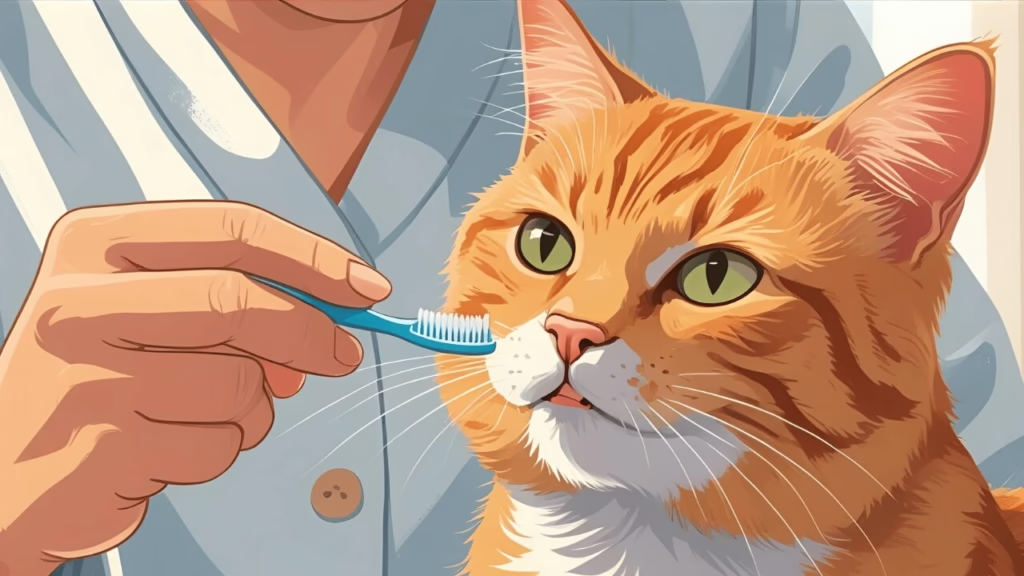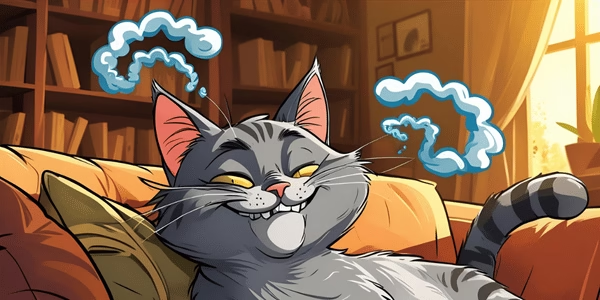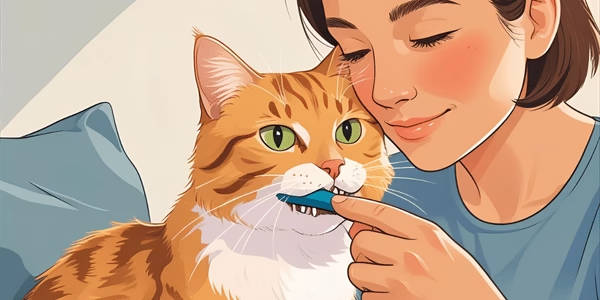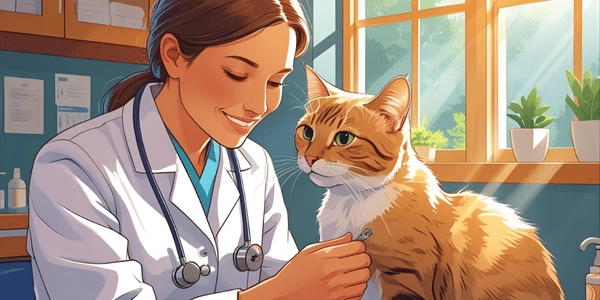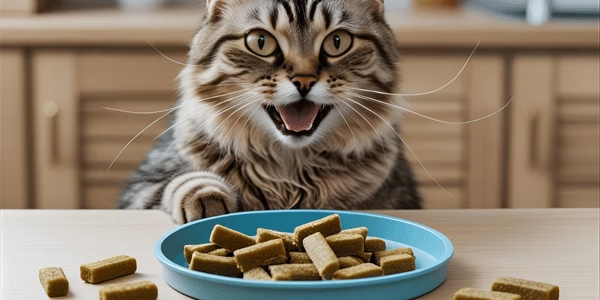This post contains affiliate links and You Site Name is a member of the Amazon Services LLC Associates Program. Which means we may receive a commission from purchases made through links at no extra cost to you. Learn more on our privacy policy page.
Your cat’s adorable little yawn might be hiding a not-so-adorable secret. While you’re admiring those tiny fangs, there could be a whole world of dental drama brewing in that fuzzy mouth. Cat dental care isn’t just about fresh breath, it’s about your feline friend’s overall health and happiness.
Here’s the thing that might surprise you: by age four, many cats have significant gingivitis, and dental disease affects their quality of life in ways you might never notice. Unlike dogs who might whimper or show obvious signs of discomfort, cats are masters of disguise when it comes to pain. They’ll suffer in silence, adapting to live with dental issues until things get really serious.
But don’t worry, you’re not powerless here. With the right knowledge and approach, you can become your cat’s dental health hero. Let’s dive into everything you need to know about keeping those pearly whites actually pearly and white.
Why Cat Dental Care Matters More Than You Think
Think dental problems are just about bad breath? Think again. Dental care for cats goes way beyond cosmetic concerns, we’re talking about serious health implications that can affect your cat’s entire body.
When bacteria from dental disease enters your cat’s bloodstream, it doesn’t just stay in the mouth. These troublemakers can travel to vital organs like the heart, liver, and kidneys, potentially shortening your cat’s lifespan. It’s like having a constant source of infection that’s slowly affecting your cat’s overall health.
The pain factor is huge too. Cats with dental disease experience chronic discomfort that affects their quality of life, eating habits, and even their grooming behavior. Since cats are incredibly good at hiding pain, they often suffer much longer than we realize.
The numbers don’t lie: Between 50% and 90% of cats show signs of dental disease by age four. That’s not a small problem, that’s an epidemic hiding in plain sight.
RELATED: 7 Essential Grooming Tools For Cats
Spotting the Warning Signs: Your Cat’s Dental SOS Signals
Your cat won’t walk up to you and say, “Hey, my teeth hurt.” Instead, they’ll give you subtle (and sometimes not-so-subtle) clues that something’s wrong in their mouth.
Physical Signs to Watch For:
- Bad breath that’s gotten noticeably worse
- Red, swollen, or bleeding gums, healthy gums should be pink
- Yellow or brown tartar buildup on the teeth
- Loose, broken, or missing teeth
- Drooling, especially if there’s blood in the saliva
Behavioral Changes That Signal Trouble:
- Pawing at the mouth or face
- Difficulty eating or dropping food while chewing
- Preference for soft food over hard kibble
- Chewing more slowly than usual
- Reluctance to have their face touched
One particularly telling sign is when cats start dribbling while being petted, this can be an early indicator of dental issues. If your usually neat and tidy cat suddenly becomes a drooler during cuddle time, it’s worth a dental check.
The Home Care Playbook: Daily Dental Care for Cats
Here’s where the rubber meets the road, or should I say, where the brush meets the teeth. Home dental care is your first line of defense against dental disease, but it requires patience, the right tools, and a good strategy.
Starting the Tooth Brushing Journey
The Golden Rule: Start young if possible, but don’t give up if your cat is older. Even senior cats can learn to tolerate tooth brushing with patience and positive reinforcement.
Week-by-Week Cat Teeth Brushing Tutorial
- Weeks 1–2: Make mouth contact.
- Pet your cat’s cheeks and lips with your finger during cuddle sessions.
- Offer treats and praise for any calm tolerance (do not rush this step).
- Weeks 3–4: Lift the lips, touch teeth.
- Gently lift your cat’s lips for a couple seconds while petting.
- Touch along the gumline, use treats and a calm, upbeat tone.
- Weeks 5–6: Finger brush or gauze introduction.
- Gently rub teeth and gums using a cat finger brush or gauze wrapped around your finger.
- Start without toothpaste, progressing to using a cat-specific toothpaste.
- Week 7 and beyond: Soft toothbrush training.
- Transition to a soft, cat-sized toothbrush with cat-safe toothpaste.
- Focus on the outside surfaces of the teeth, keep sessions under a minute and reward after.
Tip: Never use human toothpaste, ingredients can be toxic to cats.
Tip: If brushing is skipped, use dental wipes and start over from step 1 if needed.
Pro Tips for Success:
- Use cat-specific toothpaste, human toothpaste can be toxic to cats
- Keep sessions short, 30 seconds to start is plenty
- Reward heavily with treats and praise
- Focus on the outer surfaces of teeth where plaque builds up most
Recommended Cat Dental Care Products (Amazon Picks)
- Virbac C.E.T. Enzymatic Cat Toothpaste and Toothbrush Kit
(Cat-safe poultry-flavored toothpaste & double-ended toothbrush) - Petrodex Dental Kit for Cats
(Includes small-bore toothbrush and malt-flavored toothpaste) - TropiClean Fresh Breath Water Additive
(Additive for drinking water to help reduce plaque and tartar) - Greenies Feline Dental Treats
(VOHC-accepted treats effective at reducing tartar buildup) - Vet’s Best Dental Wipes for Cats
(Easy-to-use wipes for cats who don’t tolerate brushing)
Alternative Dental Care Options
Not every cat will tolerate brushing, and that’s okay. There are other ways to support your cat’s oral health:
Water Additives: Special antibacterial solutions can be added to drinking water to help reduce plaque buildup. Just be aware that some cats may refuse to drink flavored water.
Dental Diets: Prescription diets are formulated to help reduce plaque and tartar through mechanical action.
Approved Products: Look for products that have been tested and proven effective for dental care.
Professional Dental Care: When to Call in the Experts
Even with excellent home care, your cat will need professional dental attention. Think of it like your own dental visits, you brush at home, but you still need professional cleanings and checkups.
The Annual Dental Exam
Every cat should have an annual dental assessment as part of their regular veterinary care. During these exams, your vet will:
- Examine the teeth and gums for signs of disease
- Check for broken or loose teeth
- Assess the need for professional cleaning
- Discuss home care strategies
Professional Dental Cleaning: What to Expect
When your vet recommends a professional cleaning, here’s what typically happens:
Pre-Anesthetic Workup: Blood tests ensure your cat is healthy enough for anesthesia.
The Cleaning Process:
- Full anesthesia for complete oral examination
- Dental X-rays to check tooth roots and hidden problems
- Scaling to remove tartar above and below the gum line
- Polishing to smooth tooth surfaces
- Treatment of any discovered issues
Why Anesthesia is Necessary: Unlike humans, cats can’t understand “open wide and hold still.” Anesthesia ensures a thorough, stress-free cleaning and allows for proper X-rays and treatment.
Common Dental Problems in Cats
Understanding what can go wrong helps you know what to watch for and why prevention is important.
Feline Odontoclastic Resorption Lesions (FORL)
These are essentially cat cavities, painful lesions that occur where the gum meets the tooth. They’re incredibly common and often require tooth extraction for relief. The tricky part? They’re often hidden below the gum line, only visible on dental X-rays.
Gingivitis and Periodontal Disease
Gingivitis is inflammation of the gums, the first stage of periodontal disease and the only reversible stage. Left untreated, it progresses to periodontal disease, which can cause tooth loss and systemic health problems.
Risk Factors for Gingivitis:
- Wet food diets (compared to dry food)
- Cats with orange coat colors
- Indoor cats who don’t hunt
- Cats who drool when petted
Stomatitis
This severe inflammatory condition affects the entire mouth and can be incredibly painful. It often requires aggressive treatment and sometimes multiple tooth extractions for relief.
Diet and Dental Health: You Are What You Eat
Your cat’s diet plays a bigger role in dental health than you might think. While wet food is great for hydration and many cats prefer it, dry food provides some mechanical cleaning action that can help reduce plaque buildup.
Dental Diet Benefits:
- Specially formulated kibble that doesn’t crumble immediately
- Fiber matrix that provides scrubbing action
- Reduced plaque and tartar formation
Nutritional Foundations:
- High-quality protein for overall health
- Avoid foods with excessive carbohydrates and preservatives
- Consider dental-specific treats as part of daily routine
Creating Your Cat’s Dental Care Routine
Consistency is key when it comes to dental care. Here’s how to build a sustainable routine:
Daily (Ideal):
- Tooth brushing or finger brushing
- Dental treats or chews
- Fresh water (with additive if tolerated)
Weekly:
- Thorough mouth examination
- Assessment of breath quality
- Check for any changes in eating behavior
Annually:
- Professional veterinary dental exam
- Professional cleaning if recommended
- Update home care strategy based on vet recommendations
The Cost of Prevention vs. Treatment
Let’s talk numbers for a moment. Prevention is always cheaper than treatment. A tube of cat toothpaste and a brush might cost $15-20 and last months. Compare that to the cost of treating advanced dental disease, which can run into hundreds or thousands of dollars.
Professional cleaning costs typically range from $300-800, depending on your location and what’s needed. Tooth extractions can add significantly to that cost. But here’s the thing, catching problems early through regular care can prevent the need for extensive (and expensive) treatments later.
Your Next Steps: Taking Action Today
Cat dental care doesn’t have to be overwhelming. Start small, be consistent, and remember that any effort is better than no effort. Your cat might not thank you in words, but their improved health and comfort will speak volumes.
This Week:
- Schedule your cat’s annual dental exam if it’s overdue
- Pick up cat-specific toothpaste and a soft brush
- Start touching your cat’s mouth during petting sessions
This Month:
- Begin a gentle tooth brushing routine
- Evaluate your cat’s diet for dental health benefits
- Watch for any warning signs of dental problems
Remember, you’re not just caring for teeth, you’re investing in your cat’s overall health, comfort, and quality of life. And honestly? That’s what being a great cat parent is all about.
FAQ: Your Top Cat Dental Care Questions Answered
Q: How often should I brush my cat’s teeth?
A: Ideally daily, but even 2-3 times per week provides significant benefits. The key is consistency rather than perfection.
Q: Can I use human toothpaste on my cat?
A: Absolutely not. Human toothpaste contains ingredients that are toxic to cats. Always use toothpaste specifically formulated for cats.
Q: My cat won’t let me brush their teeth. What else can I do?
A: Try water additives, dental diets, approved treats, or dental wipes. Even these alternatives provide some benefit, though brushing remains the gold standard.
Q: How do I know if my cat needs professional dental cleaning?
A: Your vet will assess this during annual exams, but signs include bad breath, visible tartar, red gums, or changes in eating behavior.
Q: Are dental treats really effective?
A: Approved dental treats have been proven to help reduce plaque and tartar, but they’re supplements to, not replacements for, regular brushing.
Resources
https://www.vohc.org/
https://www.aaha.org/

